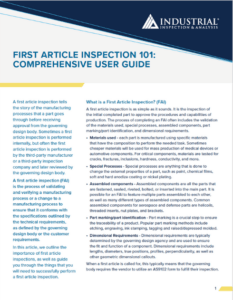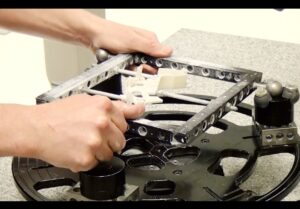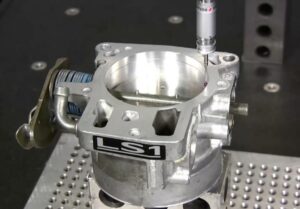IIA: the first name in first article inspectionsFirst Article Inspection
There’s no room for error when it comes to the safety and quality of your manufactured product.
As a leading inspection provider, Industrial Inspection & Analysis (IIA) performs first article inspections on a wide variety of items — large or small, simple or complex.
A first article inspection tells the story of the manufacturing processes that a part goes through before receiving approval from the governing design body. The FAI verifies that a manufacturing process can consistently produce products that meet specifications — or identifies discrepancies that need to be addressed.
FAI is a fantastic tool for documenting the materials, special processes, assembled components, part marking/part identification, and dimensional requirements outlined by the customer.
Talk To An Expert
Don’t see exactly what you are looking for? Or maybe you do and want more specifics or an estimate. Either way, you can call us at
470-264-5765
right now or just fill out the form below and we will respond back within 24 hours.
When should you have a First Article Inspection?

First Production Run

Design Change

Materials or Source Change

2+ Years Since Last Run

Change In Process, Tool, Location
A first article inspection is a good idea when faced with any of the following scenarios:
- First Production Run
- Change to Product Design
- Change to a Manufacturing Process
- Change to Materials & Sourcing
- Change to Tools Used in Manufacturing
- Change in Manufacturing Location
- After Production Lapse of 2+ Years
When dealing with manufacturing process changes and other alterations, an FAI will help show that the changes did not adversely impact the manufacturing process or product quality.
Partial/Delta FAI
While some scenarios — such as a change in the manufacturing process — require a complete new first article inspection; a partial FAI may be appropriate for less sweeping changes. Also known as a delta FAI, a partial FAI will help identify differences between the latest design and the original FAI.
What is the Alternative to a First Article Inspection?
Most quality management systems require part verification and documentation to validate manufacturing process capability, but not all governing standards explicitly require a first article inspection. The first article inspection requirement is only applied universally to aerospace parts (AS9100 D).
If a first article inspection is not required, typically, any inspection report or collected data that can objectively prove compliance to customer and regulatory requirements is acceptable, such as dimensional inspection reports, CMM data reports, and production inspection logs.
FAI Reports
First Article Inspection Reports may vary in the way the information is presented. For example, there are industry standard reporting formats, such as AS9102, as well as formatting and layouts specific to individual customers. Regardless of format, an FAI report will typically contain the following documentation:
- Design Records
- Material Certificate
- Raw Material Test Results
- Dimensional Inspection Report
- Special Process Certificates
- Balloon Drawing
- Measurement System Traceability
- Other Requested Documents
IIA’s FAI reports utilize the dimensional properties of a production part in comparison to design specifications and may include the form, orientation, shape, or runout of multiple features; distances between edges; positions, diameters and shapes of holes; weight; density; stiffness; color or surface finish.
What is an AS9102 Form?
Not all parts from every industry require an official first article inspection on an AS9102 form, but it is almost universally used for all produced parts in the aerospace and defense industries. The AS9102 form lays out a template for collecting and reporting important information about materials, special processes, and dimensional requirements. However, it is common for customers to add fields to accommodate their own specific requirements.
An AS9102 First Article Inspection Report (FAIR) includes three forms:
- FORM 1: Part Number Accountability includes important information about the organization, as well as all part numbers and revision levels involved.
- FORM 2: Product Accountability includes information for materials, special processes, and functional testing requirements.
- FORM 3: Characteristic Accountability includes dimensional verification and blueprint requirement verifications.
Why Choose IIA?
Perhaps you have no in-house metrology capability, or your in-house team is stretched too thin. You may even want to have your in-house inspection verified. Informed by ASME and GD&T standards, we deliver exceptionally comprehensive and accurate data and offer a variety of easy-to-understand FAI reports, as well as custom formats to meet your unique needs. IIA provides highly accurate First Article Inspections that meet your specifications and schedule — and service that exceeds your expectations.
Resources



Qualifications, Accreditations, and Certifications
All inspectors are certified to one or more of the following:
- CQI (Certified Quality Inspector)
- CMI (Certified Mechanical Inspector)
- CQT (Certified Quality Technician)
- CQE (Certified Quality Engineer)
- CQM (Certified Quality Manager)
- CQA (Certified Quality Auditor)
- A2LA Accredited to ISO/IEC 17025: 2005
- ASQ Certifications
- ITAR, JCP and SAM Registered
- DCS Certified
- NADCA Participation
- Federal Firearms License
- A2LA Testing Cert: 1172.01
- Duns Number: 19-993-4829
- NAICS: 541380 (Mech. Testing Lab or Services)
- Cage Code: 0GB04
- SIC Code: 8734
